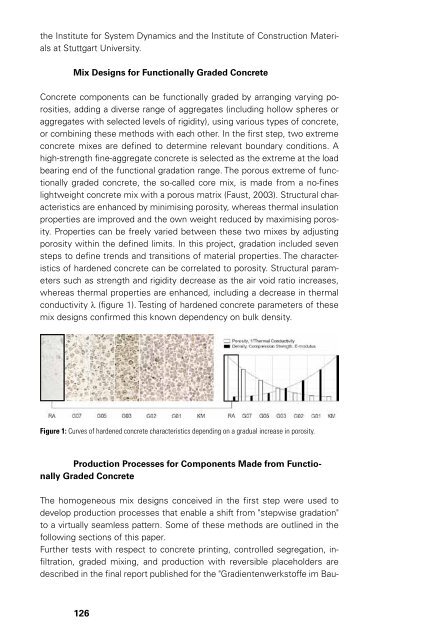Mixed Matters
ISBN 978-3-86859-421-8
ISBN 978-3-86859-421-8
You also want an ePaper? Increase the reach of your titles
YUMPU automatically turns print PDFs into web optimized ePapers that Google loves.
the Institute for System Dynamics and the Institute of Construction Materials<br />
at Stuttgart University.<br />
Mix Designs for Functionally Graded Concrete<br />
Concrete components can be functionally graded by arranging varying porosities,<br />
adding a diverse range of aggregates (including hollow spheres or<br />
aggregates with selected levels of rigidity), using various types of concrete,<br />
or combining these methods with each other. In the first step, two extreme<br />
concrete mixes are defined to determine relevant boundary conditions. A<br />
high-strength fine-aggregate concrete is selected as the extreme at the load<br />
bearing end of the functional gradation range. The porous extreme of functionally<br />
graded concrete, the so-called core mix, is made from a no-fines<br />
lightweight concrete mix with a porous matrix (Faust, 2003). Structural characteristics<br />
are enhanced by minimising porosity, whereas thermal insulation<br />
properties are improved and the own weight reduced by maximising porosity.<br />
Properties can be freely varied between these two mixes by adjusting<br />
porosity within the defined limits. In this project, gradation included seven<br />
steps to define trends and transitions of material properties. The characteristics<br />
of hardened concrete can be correlated to porosity. Structural parameters<br />
such as strength and rigidity decrease as the air void ratio increases,<br />
whereas thermal properties are enhanced, including a decrease in thermal<br />
conductivity λ (figure 1). Testing of hardened concrete parameters of these<br />
mix designs confirmed this known dependency on bulk density.<br />
Figure 1: Curves of hardened concrete characteristics depending on a gradual increase in porosity.<br />
Production Processes for Components Made from Functionally<br />
Graded Concrete<br />
The homogeneous mix designs conceived in the first step were used to<br />
develop production processes that enable a shift from "stepwise gradation"<br />
to a virtually seamless pattern. Some of these methods are outlined in the<br />
following sections of this paper.<br />
Further tests with respect to concrete printing, controlled segregation, infiltration,<br />
graded mixing, and production with reversible placeholders are<br />
described in the final report published for the "Gradientenwerkstoffe im Bau-<br />
126


















